- DAIMYO (or DAIMO) FLAGS
- 1) Generically, a term for those flags that were in use prior
to the Japanese Imperial restoration of 1868/71 a nobobi, hata-sashimono and/or sashimono (see also
hinomaru and mon)
- 2) Specifically, a term that refers to the personal and war flags of Japanese feudal lords,
and in use until the 17th Century.
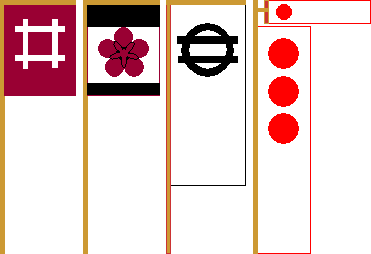
- DANCETTY (or DANCETTΙ)
- The heraldic term used when an ordinary such as a fess, bend or pale, or the line of a
division on a shield, banner of arms or flag, is saw-toothed indented, dancettι, dentelι or
dentilly - but see serrated (also
ordinary and wolfteeth).


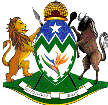
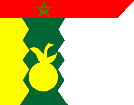
Arms and Flag Nazarι, Portugal (Antonio Martins); Arms of KwaZulu-Natal, South Africa (fotw);
Flag of Tetouan 1968 76, Morocco (fotw)
- DANGER FLAG
- See red flag 1).
- DANNEBROG
- Literally Danish-cloth, and the current national flag of Denmark. (see also
splittflag)

National Flag of Denmark (fotw)
- DE FACTO
- 1. (adj) A generally employed Latin term for in practice, and used in vexillology
to indicate flags in actual use as opposed to those as laid down by law or regulation
(see also de jure and the note below).
- 2. (adj) A term sometimes employed to describe a flag which is in use, but which has not
been officially established by law or regulation but see note below de jure.
- DE JURE
- (adj) A generally employed Latin term for in law, and used in vexillology
to indicate a flag as laid down by law or regulation, as opposed to those in actual
use (see also flag law,
de facto,
specification sheet,
and the notes below).
Please note, it is suggested that the above terms
should not be used when describing a flag for which no known official specifications
exist, therefore, no de jure design from which a de facto flag may differ, and
under these circumstances we recommend that the term variant be employed - see
variant 2).
Please note also that an example of de jure as opposed
to de facto is the proportions of the Belgian national flag which is regulated
at 13:15, but which is most often see in practice with the civil ensign ratio of 2:3.

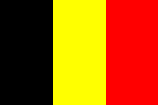
National Flag of Belgium as regulated, plus the Civil Ensign of Belgium as regulated (which is also the de facto National Flag)
- DEBASED
- See reversed 2).
- DEBRUISED
- A heraldic term used in place of surmounted by particularly when a charge or ordinary (which may or may not touch the field) is being placed over an animal but see surmounted, by (also charge 1),
ensigned, ordinary and overall 2)).
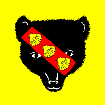
Flag of LAbbaye, Switzerland (fotw)
- DECKING
- A term for the custom of foot guards in British and Canadian service of placing
a garland or chaplet of laurel a crown triumphal - at the top of the regimental
colour pike or staff on days of significance in regimental history (see also
colour 2),
colours 2),
crown triumphal,
garland,
pike,
staff 2) and
wreath of immortelles).
- DECOMMISSIONING PENNANT
- See paying off pennant.
- DECORATED
- See garnished.
- DECRESCENT (or DECREMENT)
- See moon 2) with following note.
- DEFACE
- 1. (v) In UK usage and some others, a term for the addition of any authorised
(or apparently authorized) emblem, badge, shield, charge or device to a flag
(see also
archivexillum,
badge,
charge,
'device',
emblem
shield) and
'undefaced'.
- 2. (v) In US usage and some others, the term may also be used to include any unauthorized addition but see note below.
Please note that in heraldry and vexillology the
term has no pejorative connotation (but see also
desecrate and/or
'disfigure').
- DEMI (or DEMY)
- The heraldic term used when the front or upper half of an animal, or one-half of another charge is shown on a shield,
banner of arms or a flag but see note below demy or semi.


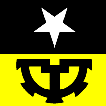
Flag of Pardubice, Czech Republic (fotw); Flag of Romoos, Switzerland (fotw);
Flag of Gurtmellen, Switzerland (fotw)
Please note, however, that one-half of an animal or other charge that is placed
against the centre line of a shield, banner of arms or a flag, is said to be
dimidiated.
Also please note that this term is never used alone, but always with the charge being so described for example a demi-horse as shown above.
- DEMONSTRATION BANNER
- See banner 3).
- DENTELΙ (or DENTILLY)
- See dancetty (also serrated).
- DEPTH
- See width 1).
- DESCATE
- (adj) A term used to describe a rounded (or lanceolate) fly into which a V shaped notch
has been cut, and a shape often seen in UK cavalry guidons cloven descate or
rounded swallowtail (see also
fly 1),
guidon 2),
hussar cut,
lanceolate,
pennant and
swallow tail(ed)).
![[descate flag]](../images/v/vxt-d109.gif)
Guidon of the Metropolitan Police Mounted Branch, UK (Herman FMY)
- DESCENDING DIAGONAL
- 1) The term for a diagonal stripe that runs from the upper hoist to the
lower fly, and is centred on the corners of the flag a bend, falling
diagonal or hoist-diagonal - but see
bend in Appendix VI and
Appendix IX(also
ascending diagonal,
east-south diagonal,
east-west diagonal,
north-east diagonal,
north-south diagonal,
south-east diagonal,
south-north diagonal,
west-east diagonal,
west-north diagonal,
and west-south diagonal.
- 2) The term may also be used to describe the division line on a bicolour
divided diagonally as shown below but see per bend 1)
(also bicolour 1)).
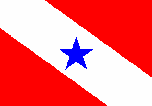
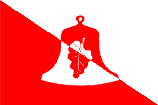
Flag of Parα, Brazil (fotw); Flag of Raov, Czech Republic (fotw)
- DESECRATE
- 1) (v) To maliciously damage or mistreat a flag for political or other motives, or to use a flag in a way that is
considered disrespectful or inappropriate (see also rules of respect and
Appendix II).
- 2) See disfigure.
- DESIGNATING (OF HEADQUARTERS) FLAG
- See headquarters flag 2).
- DESK FLAG (or DESK TOP FLAG)
- See table flag.
- DESTINATION FLAG
- The term describing a custom whereby the flag of the country of destination
may be flown at the fore by a merchant ship or pleasure vessel
when about to sail (see also fore).
- DEVICE
- 1) Originally a heraldic term for a temporary mark extra to the coat of arms
to distinguish those who entered the lists at tournaments, it now refers specifically
to the motto (see motto).
- 2) A term sometimes inaccurately applied to a charge, badge or emblem (see
also badge,
charge and
emblem).
- DEXTER
- The heraldic term for the right hand side of a flag or shield from the point
of view of the bearer, or the left hand side from the point of view of an observer
(see also sinister).
- DEXTER EDGE
- 1. With regard to a shield see dexter above.
- 2. A term that may be used in describing the left hand facing edge of a banner or
gonfalon which is hung from a crossbar, and equivalent to the top edge of a conventionally
hoisted flag the leading edge (see also
banner 2) and
gonfalon).










![[descate flag]](../images/v/vxt-d109.gif)






